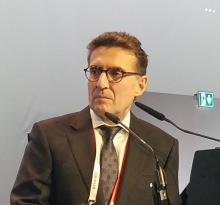BERLIN – Evobrutinib, an investigational inhibitor of Bruton’s tyrosine kinase (BTK), significantly reduced the number of new T1 gadolinium-enhancing lesions at 24 weeks compared with placebo in patients with relapsing multiples sclerosis (MS).
However, the molecule was also associated with grade 3 and 4 elevations in alanine aminotransferase – a troubling finding, Xavier Montalban, MD, said at the annual congress of the European Committee for Treatment and Research in Multiple Sclerosis.
“Fortunately, all patients were asymptomatic, and the elevations were completely reversible. The results of this trial do support further development of this molecule,” said Dr. Montalban, director of the Multiple Sclerosis Centre of Catalonia at the Vall d’Hebron University Hospital in Barcelona.
Evobrutinib exerts a dual action in MS, Dr. Montalban said. By inhibiting BTK, the drug blocks B-cell activation and interaction between B and T cells. It also inhibits macrophage survival and dampens cytokine release, he said.
The study randomized 213 patients with relapsing MS to placebo or to evobrutinib in three daily doses: 25 mg, 75 mg, or 150 mg. A control arm of 54 additional patients received treatment with dimethyl fumarate. After 24 weeks of randomized treatment, patients who got placebo switched to 25 mg per day; everyone else continued in their assigned groups for another 24 weeks. The study concluded with an open-label extension phase during which everyone took 75 mg daily.
Dr. Montalban reported the primary 24-week analysis. The remainder of the data has not been analyzed yet, he said. The primary endpoint was the total number of T1 gadolinium-enhancing lesions at weeks 12, 16, 20, and 24. Secondary endpoints included the 24-week annualized relapse rate and safety signals. Patients were a mean of 41 years old, with a mean disease duration of 10 years. They had experienced a mean of two relapses in the prior 2 years. About 20% had gadolinium-enhancing lesions at baseline.
Compared with placebo and with the 25-mg dose, evobrutinib 75 mg and 150 mg significantly reduced the number of new enhancing lesions at 24 weeks. There was evidence of a dose-response effect, Dr. Montalban said. Patients taking placebo developed a mean of 3.8 new lesions, while those on 75 mg developed a mean of 1.69 and those taking 150 mg, a mean of 1.15. Patients in the 25-mg group developed a mean of four new lesions – not significantly different than placebo.
Both the 75-mg and 150-mg doses decreased the annualized relapse rate, compared with placebo but missed statistical significance, with P values of 0.90 and 0.63, respectively.
These two doses also conferred significant benefit on two other secondary endpoints, significantly reducing the number of new or enlarging T2 lesions and reducing the total T2 lesion volume, compared with placebo.
The safety profile was relatively benign, with no infections, including no opportunistic infections, and no neoplasms. About 7% of the highest-dose group experienced nausea, and the same number, arthralgia. Seven patients taking evobrutinib experienced grade 1 lymphopenia, compared with three patients taking placebo; grade 2 lymphopenia developed in one patient in the highest-dose group.
ALT elevation was the most concerning adverse event, Dr. Montalban said. Grade 1 elevations developed in 17% of the low-dose group and about 22% of the other two active groups (11 patients each), compared with 7% of the placebo group. Grade 2 elevations developed in three placebo patients and in two taking the highest dose of evobrutinib. There was one grade 3 elevation, which occurred in a patient in the highest-dose group. These were asymptomatic and resolved after discontinuing the medication. Lipase and aspartate transaminase elevations were also associated with evobrutinib, but Dr. Montalban did not provide these details.
He has been a paid consultant for Merck Serono, which is developing evobrutinib.
SOURCE: Montalban X et al. ECTRIMS 2018. Abstract 322.


